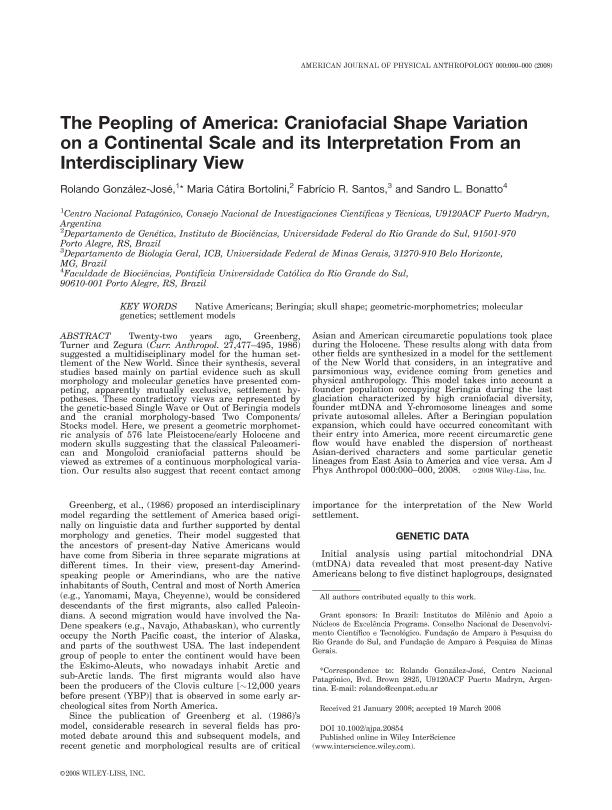Mostrar el registro sencillo del ítem
dc.contributor.author
González José, Rolando

dc.contributor.author
Bortolini, María Cátira

dc.contributor.author
Santos, Fabricio R.

dc.contributor.author
Bonatto, Sandro Luis

dc.date.available
2020-03-30T15:17:07Z
dc.date.issued
2008-12
dc.identifier.citation
González José, Rolando; Bortolini, María Cátira; Santos, Fabricio R.; Bonatto, Sandro Luis; The Peopling of America: craniofacial shape variation on a continental scale and its interpretation from an interdisciplinary view; Wiley-liss, Div John Wiley & Sons Inc; American Journal Of Physical Anthropology; 137; 12-2008; 175-187
dc.identifier.issn
0002-9483
dc.identifier.uri
http://hdl.handle.net/11336/101290
dc.description.abstract
Twenty-two years ago, Greenberg, Turner and Zegura (Curr. Anthropol. 27,477-495, 1986) suggested a multidisciplinary model for the human settlement of the New World. Since their synthesis, several studies based mainly on partial evidence such as skull morphology and molecular genetics have presented competing, apparently mutually exclusive, settlement hypotheses. These contradictory views are represented by the genetic-based “Single Wave” or “Out of Beringia” model and the cranial morphology-based “Two Components/Stocks” model. Here, we present a geometric morphometric analysis of 576 late Pleistocene/early Holocene and modern skulls suggesting that the classical “Paleoamerican” and “Mongoloid” craniofacial patterns should be viewed as extremes of a continuous morphological variation. Our results also suggest that recent contact among Asian and American circumarctic populations took place during the Holocene. These results along with data from other fields are synthesized in a model for the settlement of the New World that considers, in an integrative and parsimonious way, evidence coming from genetics and physical anthropology. This model takes into account a founder population occupying Beringia during the last glaciation characterized by high craniofacial diversity, founder mtDNA and Y-chromosome lineages, and some private autosomal alleles. After a Beringian population expansion, which could have occurred concomitant with their entry into America, more recent circumarctic gene flow would have enabled the dispersion of northeast Asian-derived characters and some particular genetic lineages from East Asia to America and vice versa.
dc.format
application/pdf
dc.language.iso
eng
dc.publisher
Wiley-liss, Div John Wiley & Sons Inc

dc.rights
info:eu-repo/semantics/openAccess
dc.rights.uri
https://creativecommons.org/licenses/by-nc-sa/2.5/ar/
dc.subject
AMERICAN SETTLEMENT
dc.subject
GEOMETRIC MORPHOMETRICS
dc.subject
SKULL SHAPE
dc.subject
MOLECULAR GENETICS
dc.subject.classification
Otros Tópicos Biológicos

dc.subject.classification
Ciencias Biológicas

dc.subject.classification
CIENCIAS NATURALES Y EXACTAS

dc.title
The Peopling of America: craniofacial shape variation on a continental scale and its interpretation from an interdisciplinary view
dc.type
info:eu-repo/semantics/article
dc.type
info:ar-repo/semantics/artículo
dc.type
info:eu-repo/semantics/publishedVersion
dc.date.updated
2020-03-16T15:08:18Z
dc.journal.volume
137
dc.journal.pagination
175-187
dc.journal.pais
Estados Unidos

dc.description.fil
Fil: González José, Rolando. Consejo Nacional de Investigaciones Científicas y Técnicas. Centro Científico Tecnológico Conicet - Centro Nacional Patagónico. Instituto Patagónico de Ciencias Sociales y Humanas; Argentina
dc.description.fil
Fil: Bortolini, María Cátira. Universidade Federal do Rio Grande do Sul; Brasil
dc.description.fil
Fil: Santos, Fabricio R.. Universidade Federal de Minas Gerais; Brasil
dc.description.fil
Fil: Bonatto, Sandro Luis. Pontificia Universidade Católica do Rio Grande do Sul; Brasil
dc.journal.title
American Journal Of Physical Anthropology

dc.relation.alternativeid
info:eu-repo/semantics/altIdentifier/doi/http://dx.doi.org/10.1002/ajpa.20854
dc.relation.alternativeid
info:eu-repo/semantics/altIdentifier/url/https://onlinelibrary.wiley.com/doi/abs/10.1002/ajpa.20854
Archivos asociados
